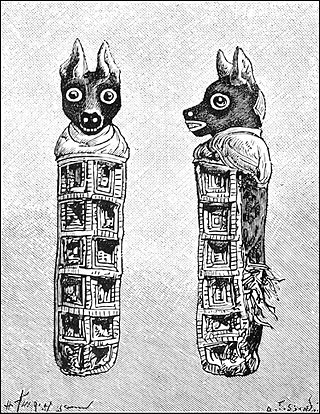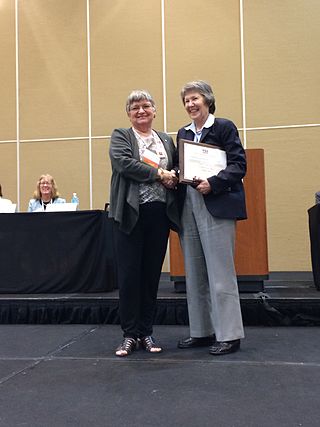Related Research Articles

The Epipalaeolithic Near East designates the Epipalaeolithic in the prehistory of the Near East. It is the period after the Upper Palaeolithic and before the Neolithic, between approximately 20,000 and 10,000 years Before Present (BP). The people of the Epipalaeolithic were nomadic hunter-gatherers who generally lived in small, seasonal camps rather than permanent villages. They made sophisticated stone tools using microliths—small, finely-produced blades that were hafted in wooden implements. These are the primary artifacts by which archaeologists recognise and classify Epipalaeolithic sites.

The Neolithic or New Stone Age is an archaeological period, the final division of the Stone Age in Europe, Asia and Africa. It saw the Neolithic Revolution, a wide-ranging set of developments that appear to have arisen independently in several parts of the world. This "Neolithic package" included the introduction of farming, domestication of animals, and change from a hunter-gatherer lifestyle to one of settlement. The term 'Neolithic' was coined by Sir John Lubbock in 1865 as a refinement of the three-age system.

Zooarchaeology, also known as faunal analysis, is a branch of archaeology that studies remains of animals from archaeological sites. Faunal remains are the items left behind when an animal dies. These include bones, shells, hair, chitin, scales, hides, proteins and DNA. Of these items, bones and shells are the ones that occur most frequently at archaeological sites where faunal remains can be found. Most of the time, a majority of these faunal remains do not survive. They often decompose or break because of various circumstances. This can cause difficulties in identifying the remains and interpreting their significance.

The 9th millennium BC spanned the years 9000 BC to 8001 BC. In chronological terms, it is the first full millennium of the current Holocene epoch that is generally reckoned to have begun by 9700 BC. It is impossible to precisely date events that happened around the time of this millennium and all dates mentioned here are estimates mostly based on geological and anthropological analysis, or by radiometric dating.

Domestication is a sustained multi-generational relationship in which humans assume a significant degree of control over the reproduction and care of another group of organisms to secure a more predictable supply of resources from that group. A broader biological definition is that it is a coevolutionary process that arises from a mutualism, in which one species constructs an environment where it actively manages both the survival and reproduction of another species in order to provide the former with resources and/or services. The domestication of plants and animals by humans was a major cultural innovation ranked in importance with the conquest of fire, the manufacturing of tools, and the development of verbal language.

A traditional hunter-gatherer or forager is a human living an ancestrally derived lifestyle in which most or all food is obtained by foraging, that is, by gathering food from local sources, especially edible wild plants but also insects, fungi, honey, or anything safe to eat, and/or by hunting game, roughly as most animal omnivores do. Hunter-gatherer societies stand in contrast to the more sedentary agricultural societies, which rely mainly on cultivating crops and raising domesticated animals for food production, although the boundaries between the two ways of living are not completely distinct.

Göbekli Tepe is a Neolithic archaeological site in the Southeastern Anatolia Region of Turkey. Dated to the Pre-Pottery Neolithic, between c. 9500 and 8000 BCE, the site comprises a number of large circular structures supported by massive stone pillars – the world's oldest known megaliths. Many of these pillars are richly decorated with figurative anthropomorphic details, clothing, and reliefs of wild animals, providing archaeologists rare insights into prehistoric religion and the particular iconography of the period. The 15 m (50 ft)-high, 8 ha (20-acre) tell also includes many smaller buildings, quarries, and stone-cut cisterns from the Neolithic, as well as some traces of activity from later periods.

The Neolithic Revolution, or the (First) Agricultural Revolution, was the wide-scale transition of many human cultures during the Neolithic period from a lifestyle of hunting and gathering to one of agriculture and settlement, making an increasingly large population possible. These settled communities permitted humans to observe and experiment with plants, learning how they grew and developed. This new knowledge led to the domestication of plants into crops.

The founder crops are the eight plant species that were domesticated by early Neolithic farming communities in Southwest Asia and went on to form the basis of agricultural economies across much of Eurasia, including Southwest Asia, South Asia, Europe, and North Africa. They consist of three cereals, four pulses, and flax. These species were amongst the first domesticated plants in the world.

Franchthi Cave or Frankhthi Cave is an archaeological site overlooking Kiladha Bay, in the Argolic Gulf, opposite the village of Kiladha in southeastern Argolis, Greece.

The Hilly Flanks are the upland areas surrounding the Fertile Crescent of Southwest Asia, including the foothills of the Zagros Mountains, the Taurus Mountains, and the highland parts of the Levant. The Hilly Flanks foothill chain spans over 1000 miles, including parts of Turkey, northwestern Iraq, and western Iran. The region is just north of Mesopotamia, with similar characteristics of fertility with the added trait of foothills and plateaus.

Prehistory, also known as pre-literary history, is the period of human history between the first known use of stone tools by hominins c. 3.3 million years ago and the beginning of recorded history with the invention of writing systems. The use of symbols, marks, and images appears very early among humans, but the earliest known writing systems appeared c. 5000 years ago. It took thousands of years for writing systems to be widely adopted, with writing spreading to almost all cultures by the 19th century. The end of prehistory therefore came at very different times in different places, and the term is less often used in discussing societies where prehistory ended relatively recently.
Archaeobiology, the study of the biology of ancient times through archaeological materials, is a subspecialty of archaeology. It can be seen as a blanket term for paleobotany, animal osteology, zooarchaeology, microbiology, and many other sub-disciplines. Specifically, plant and animal remains are also called ecofacts. Sometimes these ecofacts can be left by humans and sometimes they can be naturally occurring. Archaeobiology tends to focus on more recent finds, so the difference between archaeobiology and palaeontology is mainly one of date: archaeobiologists typically work with more recent, non-fossilised material found at archaeological sites. Only very rarely are archaeobiological excavations performed at sites with no sign of human presence.

The Neolithic British Isles refers to the period of British, Irish and Manx history that spanned c. 4000 to c. 2,500 BCE. The final part of the Stone Age in the British Isles, it was a part of the greater Neolithic, or "New Stone Age", across Europe. It was preceded by the Mesolithic and followed by the Bronze Age.
Iraq ed-Dubb, or the Cave of the Bear, is an early Neolithic archeological site 7 km (4.3 mi) northwest of Ajlun in the Jordan Valley, in modern-day Jordan. The settlement existed before 8,000 BCE and experimented with the cultivation of founder crops, side by side with the harvesting of wild cereals. Along with Tell Aswad in Syria, the site shows the earliest reference to domestic hulled barley between 10,000 and 8,800 BCE. The site is located on a forested limestone escarpment above the Wadi el-Yabis in northwest Jordan. An oval-shaped stone structure was excavated along with two burials and a variety of animal and plant remains.
Karim Sadr is an archaeologist contributing to research in southern Africa. He is the author of over 60 academic articles, a book and two edited volumes. While Sadr has contributed to the Kalahari Debate, his more recent work has focused on historical revision, re-examining the acquisition of domesticated animals and pottery in southern Africa by Hunter-gatherer. His work is reintroducing the term Neolithic back into southern African archaeological discourse from which it had previously been removed.
Ifri Oudadane is an archaeological site in the northeastern Rif region of Morocco. It is located on the southwestern coast of the Cape Three Forks on the Mediterranean Sea, and is one of the most important sites in the northwestern Maghreb region of Africa. Discovered during road construction, the site consists of a fairly large rock shelter above the modern coastline, the site has been excavated since 2006 by a team of Moroccan and German archaeologists. Although much is known about the transition of humans from hunter gatherer groups to food production in Europe and the Middle East, much of North Africa has not been researched. Ifri Oudadane is one of the first of such sites in North Africa. Dated to between 11000 and 5700 years BP, the site contains evidence that documents the shift of local inhabitants from hunter-gatherer groups to food producers. Such elements of change found at Ifri Oudadane include evidence of animal husbandry, domestication of legumes, and decoration of pottery. The site is known to contain the earliest dated crop in Northern Africa, a lentil.

Diane Gifford-Gonzalez is an American archaeologist who specializes in the field of zooarchaeology. Her research has included fieldwork near Lake Turkana, northwestern Kenya, and her research often touches on the question of animal domestication and the origins and development of African pastoralism.

Anna Belfer-Cohen is an Israeli archaeologist and paleoanthropologist and Professor Emeritus at the Institute of Archaeology, The Hebrew University of Jerusalem. Belfer-Cohen excavated and studied many important prehistoric sites in Israel including Hayonim and Kebara Caves and open-air sites such as Nahal Ein Gev I and Nahal Neqarot. She has also worked for many years in the Republic of Georgia, where she made important contributions to the study of the Paleolithic sequence of the Caucasus following her work at the cave sites of Dzoudzuana, Kotias and Satsrublia. She is a specialist in biological Anthropology, prehistoric art, lithic technology, the Upper Paleolithic and modern humans, the Natufian-Neolithic interface and the transition to village life.
Umberto Albarella is an Italian-British archaeologist, prehistorian, and activist. He is professor of Zooarchaeology at the Department of Archaeology, University of Sheffield. Albarella's previous work has been based in Britain, Italy, Armenia, Greece, the Netherlands, Germany, Switzerland, France, and Portugal.
References
- 1 2 Hancock, Elaina (2015-10-21). "A Bare Bones Approach to Understanding Human Behavior". UConn Today. Retrieved 2023-04-10.
- ↑ Research, Anna Zarra Aldrich '20 (CLAS), Office of the Vice President (2021-05-20). "Meet the Researcher: Natalie Munro, College of Liberal Arts and Sciences". UConn Today. Retrieved 2023-04-10.
- ↑ "From Hunting to Herding: The Emergence of Animal Domestication in Southwest Asia, a talk by Natalie Munro (University of Connecticut)". anthropology.fas.harvard.edu. Retrieved 2023-04-10.
- ↑ Tuesday, 31 August 2010 AFP (2010-08-31). "Communal feasts date back 12,000 years". www.abc.net.au. Retrieved 2023-04-10.
- ↑ Hancock, Elaina (2018-08-31). "Snapshot: Natalie Munro in Israel". UConn Today. Retrieved 2023-04-10.
- ↑ "Party like it's 10000 BC: new archaeological find in Israel". Christian Science Monitor. ISSN 0882-7729 . Retrieved 2023-04-10.
- ↑ Archaeology, Current World (2010-11-06). "Feasting marks the start of the Neolithic". World Archaeology. Retrieved 2023-04-10.
- ↑ Marshall, Michael. "Tortoise banquet: Remains of the oldest feast found". New Scientist. Retrieved 2023-04-10.